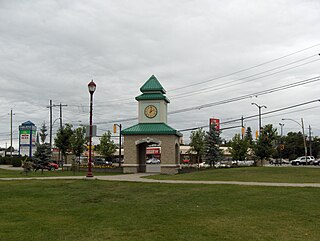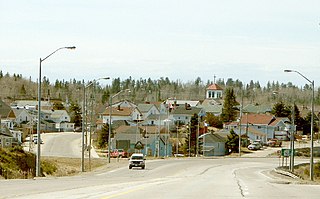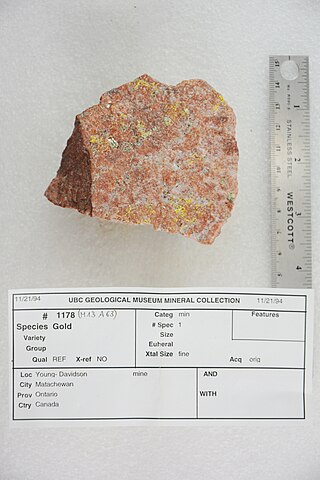
A gold rush or gold fever is a discovery of gold—sometimes accompanied by other precious metals and rare-earth minerals—that brings an onrush of miners seeking their fortune. Major gold rushes took place in the 19th century in Australia, Greece, New Zealand, Brazil, Chile, South Africa, the United States, and Canada while smaller gold rushes took place elsewhere.

Timmins is a city in northeastern Ontario, Canada, located on the Mattagami River. The city is the fourth-largest city in the Northeastern Ontario region with a population of 41,145 at the 2021 Canadian census and an estimated population of 44,819 in 2023. The city's economy is based on natural resource extraction. It is supported by industries related to lumbering, and to the mining of gold, zinc, copper, nickel, and silver. Timmins serves as a regional service and distribution centre.

Cobalt is a town in Timiskaming District, Ontario, Canada. It had a population of 989 at the 2021 Census.
Goldcorp Inc. was a gold production company headquartered in Vancouver, British Columbia, Canada. The company stood among the largest gold producers in the world, employed about 15,800 people worldwide, engaged in gold mining and related activities including exploration, extraction, processing and reclamation. Goldcorp’s operating assets included eleven mines in North and South America.

The Hollinger Gold Mine was discovered on October 9, 1909, by Benny Hollinger, who found the gold-bearing quartz dike that later became known as Hollinger Mines. With his friend, professional prospector Alex Gillies, Hollinger had travelled to the Porcupine region in the wake of the Wilson expedition, which had recently discovered the future Dome Mine site. Hollinger and Gillies staked three claims each, and one for their former partner, Bernard "Barney" P. McEnaney, who had been unable to join them due to severe sciatica.

Dome Mine is situated in the City of Timmins, Ontario, Canada; and was developed during the Porcupine Gold Rush. Last operated by Canadian company Goldcorp, before it became a subsidiary of American company Newmont, it is one of three mines owned by Newmont in the Porcupine district in and around Timmins.

Hollinger Park is a municipal park in Timmins, Ontario, located at the southeast corner of Algonquin Blvd. and Brunette Road.
Noah Anthony Timmins was a Canadian mining financier and developer who is now counted among the founding fathers of Canada's mining industry.

The McIntyre mine is an abandoned underground gold mine in Schumacher, Ontario, Canada, which has earned a place in Canadian mining history as one of the nation's most important mines. Its iconic headframe, located near downtown Timmins, has come to represent the entire Porcupine Gold Rush. The McIntyre also yielded a considerable amount of copper over its life.
The Shania Twain Centre was a city-owned tourist attraction that operated in Timmins, Ontario, from 2001 to 2013. It exhibited memorabilia, awards and other personal items loaned to the Centre by singer Shania Twain, who was raised in Timmins.

The Porcupine Gold Rush was a gold rush that took place in Northern Ontario starting in 1909 and developing fully by 1911. A combination of the hard rock of the Canadian Shield and the rapid capitalization of mining meant that smaller companies and single-man operations could not effectively mine the area, as opposed to earlier rushes where the gold could be extracted through placer mining techniques. Although a number of prospectors made their fortune, operations in the area are marked largely by the development of larger mining companies, and most people involved in the mining operations were their employees.

The city of Timmins, Ontario, Canada contains many named neighbourhoods. Some former municipalities that were merged into Timmins continue to be treated as distinct postal and telephone exchanges from the city core.
John McMartin was a businessman, mining executive and political figure in Ontario, Canada. He represented Glengarry and Stormont in the House of Commons of Canada from 1917 until his death in 1918, as a Unionist Party member.

Strataca is a salt mine museum in Hutchinson, Kansas, United States. It was previously known as the Kansas Underground Salt Museum. The museum is built within one of the world's largest deposits of rock salt, formed 275 million years ago, and provides the opportunity to go 650 feet (200 m) beneath the Earth’s surface. The museum is located in the Hutchinson Salt Company mine which began operation in 1923 as Carey Salt Company. There are 14 other salt mines in the United States, but Strataca is the only one accessible to tourists.

Ontario Mine Rescue is the program that creates, oversees and evaluates mine rescue training and standards in the province of Ontario. The Ontario Mine Rescue program is administered by Workplace Safety North, part of the prevention arm of the Ontario Ministry of Labour.
Benjamin Hollinger (1885–1919) was a Canadian barber turned prospector from Haileybury, Ontario, now considered one of the Founding Fathers of Timmins, Ontario, Canada. He was born April 10, 1885, in Point Alexander, Ontario, the youngest son of schoolteacher John Hollinger and Sarah Sutherland.
Henry Timmins was a Canadian shopkeeper who, with his younger brother, Noah, became an influential mining financier. The brothers are considered to be among the most significant founding fathers of the Canadian mining industry.
Alphonse-Arthur "Al" Paré was a Canadian mining engineer.

The Young-Davidson mine is a gold mine near Matachewan, Ontario in the Kirkland Lake area. It is one of the largest underground gold mines in Canada.












